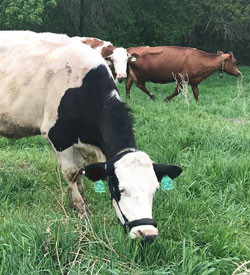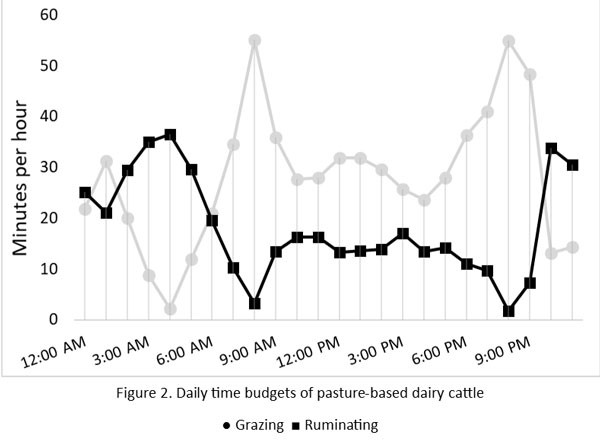By Glenda Pereira, PhD Animal Science student and Brad Heins, WCROC Dairy Scientist
September 2018
The excitement of releasing dairy animals to pasture every spring once the grass grows, never gets old. The sun has been shining and forages have been proliferating in the west central part of Minnesota. At the West Central Outreach and Research Center in Morris, MN, all dairy animals other than calves born this spring, are on pasture.

As one of the few grazing and organic dairy research herds in the country, precision dairy technologies have been used to study behaviors of pasture-based dairy cattle and of course to help manage estrus, transition and health associated behaviors. The technologies installed at the research herd collect data continuously throughout the day, month and year. To retrieve the data so it can be used in real-time, solar powered routers may be utilized. Similarly, data can be collected twice a day once cows return to the milking parlor. The data can then be viewed on a computer system, on a website and some companies have applications for mobile devices.
Currently, a project is occurring in which cattle wear a fancy (non-show) halter and pedometers to determine rumination, feed intake, water intake and locomotion. The Rumiwatch halter from Switzerland uses an oil-filled silicone tube with a built-in pressure sensor. The pressure difference caused by jaw movement, generates a signal which is transmitted to a box on the side of the noseband and this data can be downloaded. This halter is marketed for research, as the cost and the amount of data retrieved is probably not as practical to dairy producers.
Previous research has determined that most pasture-based dairy cattle graze for 8 to 10 hours per day and do so in bouts of 1.5 to 2 hours, and repeat that 4 to 5 times throughout the day. Once cattle go the pasture from the milking parlor, they tend to consume a large portion of their dry matter intake for the day. Typically, cattle will graze during the early morning and late afternoon, beginning at sunrise and ending around sunset. In the Midwest, fly pressure, humidity as well as the loss of moisture in certain forages (determining digestibility and palatability) can affect when cattle choose to graze. Even social hierarchy can determine when and how fast cattle tend to graze. Dominant cattle tend to graze on the best forages and for shorter amounts of times, having a larger bite rate, feeding faster than less dominant cattle.
A couple of weeks ago the halters were put to the test. Below is a summary (Figure 2), of daily time budgets, minutes per hour of the day that pasture-based dairy cattle grazed and ruminated. The organic research herd milks twice a day at 6:30 am and 4:30 pm, therefore cattle are brought up to the milking parlor and back to the pasture twice a day. As suspected, cattle tend to graze following the milking times, grazing for almost the full hour at 8:00 am and 8:00 pm (see Figure 2). Cattle don’t ruminate and graze at the same time, and therefore, the two are inverted. Interestingly enough, these cattle seem to graze throughout the entire day; however, summer temperatures may not have reached a consistently high temperature, and cattle may still feel comfortable grazing all day. During the nighttime, cattle tend to ruminate from 11:00 pm proceeding grazing and slowly decrease rumination time around 1:00 am where they spend time resting.
Because grazing is the main feeding behavior of pasture-based dairy cattle, temperature, forage mass and grazing ability, often influence their daily behaviors. More information about grazing dairy cattle and the use of halters and other technologies will be available in the near future.

